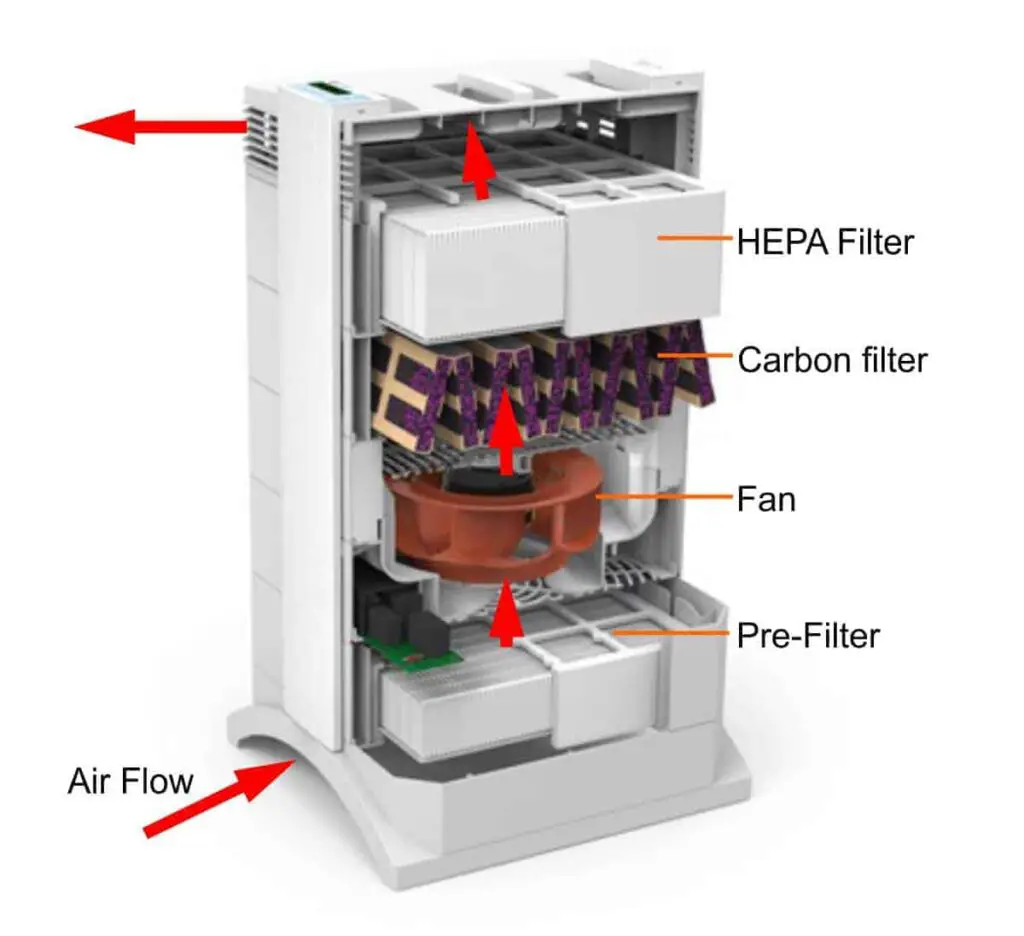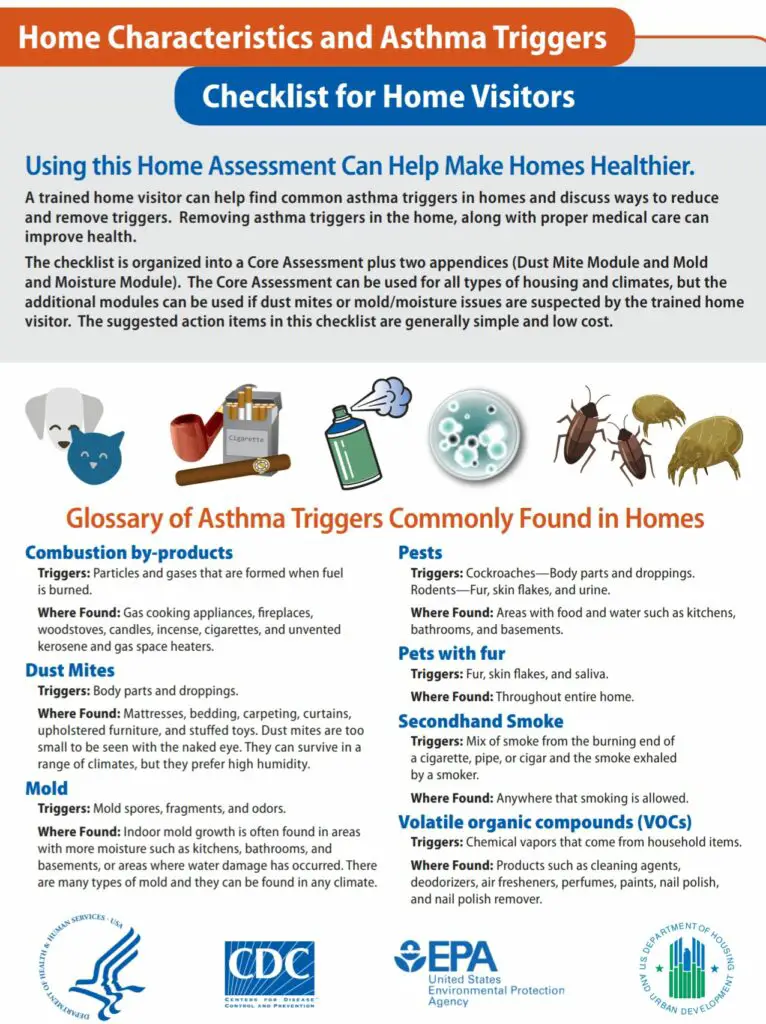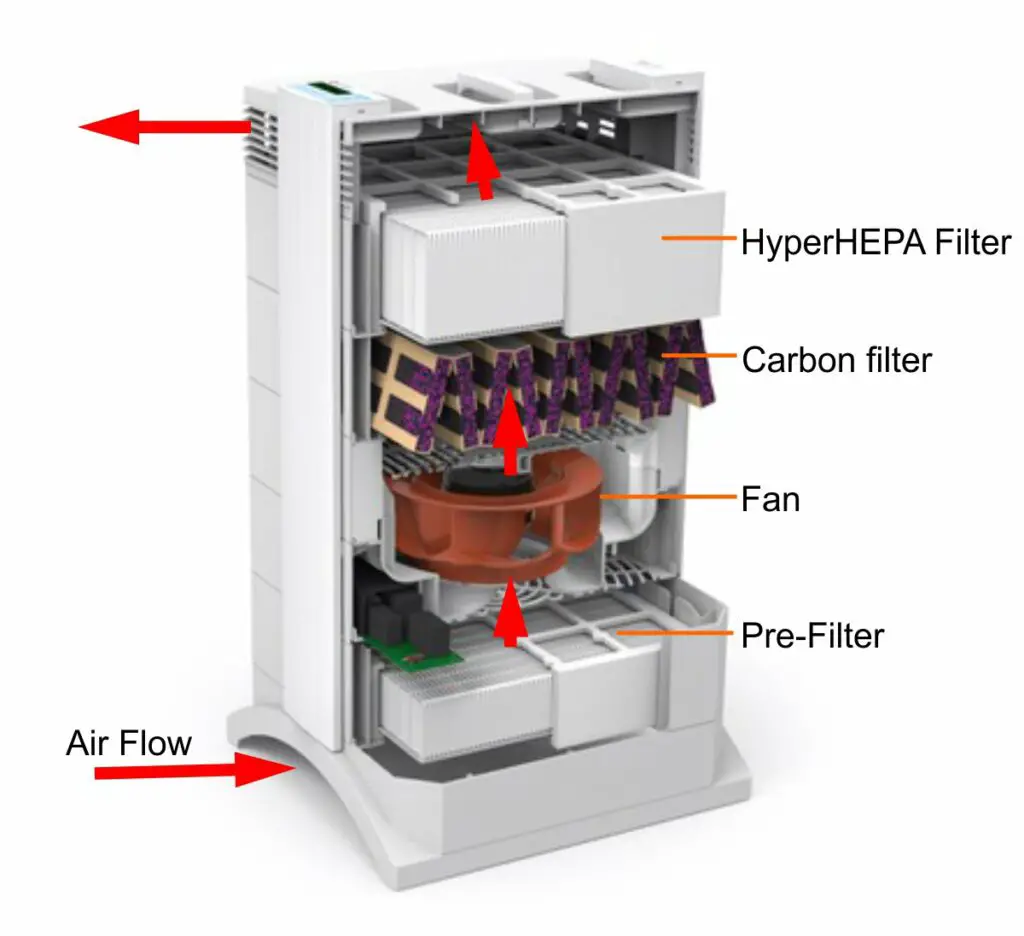Asthma is a condition whereby the airways in the lungs become narrower so it is difficult to breathe out and forcing air out of the lungs causes a wheeze. The narrowing can be caused by direct irritation of the airways by particles in the air. It has recently been recognized that in people who are overweight fat can be laid down in the airways and this can add to the narrowing. The narrowing of the airways can also be caused or triggered by breathing in allergens which cause an allergic reaction. This happens when Mast cells in the airways recognize the allergen using antibodies and then release their histamine and other granules to cause inflammation in the walls of the airways. This last mechanism is the same as that seen in allergic rhinitis. Allergic rhinitis is inflammation of the lining of the nose caused by an allergic reaction. The inflammation leads to a blocked nose, which drips and sneezing. There is no evidence that airborne allergens affect other allergic conditions.
As a general rule air purifiers help asthma and allergic rhinitis, but not other allergic conditions. Air purifiers very significantly reduce particles and volatile organic compounds in the air but have less effect on allergen count in the air. The best air purifier for asthma is the iQair HealthPro Plus.
Asthma affects 5 to 10% of the population. Air pollution can either cause asthma or if asthma is present make it worse.
Do air particles cause asthma?
Residential air pollution was associated with shortness of breath and wheeze in 2 very large European cohorts with approximately 300,000 participants. The prevalence of shortness of breath increased by 60% per 5 mcg/m³ increase in PM 2.5. There was also a 30% increase in wheeze per 5 mcg/m³ but only in the lower income participants who may have lived nearer roads.
What is the Medical Evidence for Air purifiers Having a Benefit in Asthma/Allergic Rhinitis?
Asthma
The EPA outline a total of 8 studies concerning the use of air purifiers in allergy and asthma. In summary, they find that air purification is best delivered by air purifiers rather than HVAC systems. They also find that air purifiers are quite capable of reducing particles and VOCs in the air by a large amount but that the reduction of allergen and microbial was much more limited. They felt that “the evidence indicates that air cleaners can be somewhat effective for reducing allergy or asthma symptoms”.
PM 2.5 is reduced by approximately 80% when a HEPA air purifier is placed in the bedroom. Exhaled nitric oxide, an index of inflammation in the airways, was also reduced in asthmatics when an air purifier is present in the bedroom. However, this did not lead to a decrease in symptoms.
Another study showed a slight decrease in the house dust mite antigen in the air and a decrease in PM2.5 when an air purifier was present in the bedroom. There was no decrease in symptoms.
In a randomized crossover double-blind placebo-controlled study patients were exposed to airborne cat allergen. Active air purifiers and dummy air purifiers were used. The active air purifiers reduced late asthma responses by 90%. Active air purifiers also decreased the severity of bronchial response – FEV1 decreased 17.2% with active air purifiers versus 25.6% with placebo air purifiers.
So overall air purifiers do seem to have a beneficial effect on asthma.
Allergic Rhinitis
In a double-blind trial air purifiers reduced PM 2.5 by 51.8%. The use of medication for allergic rhinitis decreased but symptoms did not. So the participants in the trial needed less medication to achieve the same symptomatic control. In another study air purifiers did help symptoms of allergic rhinitis in people who were pollen allergic. So air purifiers also seem to be helpful for allergic rhinitis
The Person With Asthma Should be Breathing Purified Air All the Time When in the Home
So the air purifier needs to run continuously for 30 minutes before the person enters the room and until the person leaves the room.To supply continuous purified air to the person with asthma, it will normally mean having an air purifier in the bedroom as well as in one of the living rooms where the person spends most of the time during the day.
An Air Purifier of the Best Possible Quality With the Highest Output is Needed
It can be really quite difficult to purify the air to medical grade standard. The air purifier needs the best possible filter such as the Hyper-HEPA filter of the iQair Air Purifiers. It also needs to have the capacity to process the air in the room 8 times per hour. There will need to be more than one purifier as the person with asthma will need one in their bedroom and also likely one in another room where they spend part of much of the day.
The Best Air Purifier for Asthma/Allergic Rhinitis
ROWENTA INTENSE PURE AIR XL (PU6020)
This air purifier has been shown to be effective in a clinical trial in reducing the response of asthmatics known to be allergic to cats. When the participants were exposed to cat allergen It reduced the asthmatic reaction.
The specifications and pros and cons are outlined in this table. In the center column are features that are in common with most air purifiers in this category. There is then a column on the left which shows the particular advantages of this model. In the right column are the potential disadvantages.
| Advantages | Average | Disadvantages |
|---|---|---|
| HEPA Filter | ||
| Carbon filter | ||
| CADR 310 (suitable for a large room) | ||
| Relatively Quiet | ||
| Small/Medium size 15.6lb | ||
| Allergy plus filter replace every 2 years | Active carbon filter replace every 12 months | Pre-filter clean every 2-4 weeks |
| Power Max 80 watt | ||
| Cost |
Table key for whole article-
- *CADR=clean air delivery rate. The volume of air processed per unit time.
- **AHAM and EPA base room size assuming 8 foot tall rooms. The EPA advises to use between 4-5 air changes per hour and so aiming for an 80% reduction in particles in the air. For asthmatics 8 changes of room air per hour are advised so the room’s size that the air purifier can supply this to is smaller. For comparison in some hospital environments, 12-16 air changes per hour are used. The room sizes are based on the air purifier being on its maximum setting. This may not always be practical because of the noise some air purifiers make on their maximum setting.
- **For each fan speed setting, it is really helpful for you to know the amount of air processed from the noise the air purifier makes people buy it. This is not in the current manual or on the website for this model of air purifier. So you may buy it and then find on the fan speed that you need to use to purify the air properly, it is too noisy to stay in the room with the purifier! So I market as a disadvantage if the manufacturer does not give you this information. For further information, see this article.
So this purifier that was effective in a clinical trial and has a good filter. The noisiness at each speed is not given, but the range of noise levels is reasonable. At the maximum setting, it will only serve a relatively small room for an asthmatic. It also needs rather frequent washes of the pre-filter–every 2 to 4 weeks.
So it is a good contender for best air purifier for asthma.
Medify MA-40
| Advantages | Average | Disadvantages |
|---|---|---|
| Filter H13 True HEPA | ||
| Carbon filter | ||
| CADR 224 (cfm.) | ||
| Noisy | ||
| Small/Medium size 15.6lb | ||
| Filter change every 6 months | ||
| Power 54 watts | ||
| Cost to buy $243 |
This air purifier has a really good filter HEPA13 specification, although the manufacturer does not specify whether it meets the HEPA 13 standard at the highest fan speeds. It may only meet the standards at lower fan speeds we simply do not know. Also, the power consumption is low. However, the specifications indicate that this is a noisy air purifier. The manufacturer, as is common, does not give data on the noise levels at each fan speed, which is unhelpful to the consumer. From the range of noise levels and the top noise level of 66 dB, it can be seen that this is really quite a noisy purifier. It also requires more maintenance than ideal needing a filter change every 6 months.
iQair Healthpro Plus
In some ways these air purifiers are the gold standard for medical-grade air purifiers available to the consumer and so the best air purifier for asthma. The reason not everybody buys one is that they cost $899 and have a fairly large physical size. This physical size and higher electricity consumption mean that they can supply all large flow of air even though the filter is very efficient. In fact, the hyper-HEPA filter is the only filter where specifications are given for particles is diameter is in the very low nanometer range. More than 90% of particles in the air are less than 0.1um that is in the nanometer range. Purifiers with other HEPA filters may be as good, but we cannot be sure.

The features are outlined below-
| Advantage | Average | Disadvantage |
|---|---|---|
| Hyper-HEPA filter specified to filter out 99.5% of particles greater than 3nm diameter | ||
| Large carbon filter 5lbs. | ||
| Suitable for a large room (CADR 300 cfm) | ||
| Full Data on noise at every fan speed | Noise-average | |
| Large 28″ tall (35lb) | ||
| Filter change Hyper-HEPA every 50 months, Carbon filter every 2 years. PreMax filter every 18 months | ||
| Power 215 watts | ||
| Optional Wooden Case | Costs $899 | |
| Warranty 10 years |
This is the gold standard of consumer air purifiers, if you have enough space and can afford it then just buy it. However, be aware it is too noisy to run continuously on settings 5 and 6 so you will end up running it on setting 3-4. The manufacturer does helpfully give data on noise and airflow at each setting.
Oransi EJ120 Air Purifier
The Oransi EJ120 Air Purifier is a real competitor for the iQair HealthPro Plus as the best air purifier for asthma. It is another air purifier that specifies particle removal down into the range of ultra-fine particles. Unfortunately it stops short of specifying down into the range of particle sizes most easily absorbed into tne human blood stream.
It is also the only other air purifier to specify noise at each airflow and here it has some real advantages. At the top airflow both the iQair and Oansi are equally loud. In fact so loud that you will not be able to tolerate either for very long. However for an airflow of around 200 cfm the iQair HealthPro Plus produces a sound level of 54db whereas the Oransi EJ120 only 33db so the Oransi is only producing about 1/4 of the noise of the iQair HealthPro!
| Advantages | Average | Disadvantages |
|---|---|---|
| HEPA MERV 17 filter specified to filter out 99.8% of particles greater than 20nm diameter | ||
| Carbon filter modest amount of carbon | Lack of pre filter protecting carbon filter | |
| Suitable for a large room (CADR 330 cfm) | ||
| Full Data on noise at every fan speed Quiet on 200 cfm setting | ||
| Medium size 19″ tall (27lb) | ||
| Filter change HEPA every 12 months Carbon filter 8-12 months | ||
| Power 52 watts | ||
| Costs $899 | ||
| Warranty 10 years |
It is ESSENTIAL to Use an Air Quality Meter/Sensor
When using an air purifier for asthma it is very important to use in a quality sensor to check the air purity. This will also allow you to assess the effect of changes that you make in the placement of the air purifier in the room, closing doors and windows etc. Having an air quality sensor is the only way that you will know that the person who has asthma is getting the best quality of air possible. Air quality monitors start at $35.
House Cleaning and Some Other Important Measures Asthmatics May Wish to Consider
Frequent cleaning is protective for asthma and allergic rhinitis. Allergens are relatively large particles which fall to the ground before they can enter an air purifier. When people walk in the room they can be thrown up into the air again. Vacuuming can remove them from the floor. A vacuum with excellent suction and a HEPA filter should be used to trap the particles. I would strongly recommend a robotic vacuum cleaner as this will allow much more frequent vacuuming to remove allergens. We found that when we got one at home the house went up to a whole new level of being dust free.
Carpets and rugs may harbour allergens. It may be worth putting rugs in a spare room or garage for a month to see if the person with asthma feels better.

Redecoration and obtaining of new furniture were also risk factors. New furniture often omits high levels of volatile organic compounds initially. Other risk factors were indoor combustion sources and traffic air pollution. In addition cats and dogs were also risk factors in this study.
There are several helpful things that an asthmatic can consider to make day to day living less likely to provoke an asthma attack. Here is a list of some of them-
- Have a robotic vacuum cleaner with a HEPA filter as mentioned above. This means it is possible to keep your home on a whole new level of being free of dust.
- Have a P100 (or if not a FFP3) specification elastomeric mask available at all times. Then if atmospheric pollution rises, only one in 10,000 particles in the air will actually be able to reach the airways in your lungs. The mask is also useful for doing any cleaning or DIY which will create particles. The elastomeric material gives the most comfortable and effective seal with the face. Filters which will remove chemicals as well can also be brought but at least consider a simple particle filtering mask with a high specification.
- Consider a medical grade air purifier-see the recommended ones in this post. Ideally buy 2 of the most expensive option, one for a day room and one for your bedroom. Most of all get an air quality monitor and aim for an AQ score of 0 or a reduction in particle count of at least 80%. The majority of people using air purifiers do not use them properly and so get really no benefit from them though poor choice of machine or almost universal poor technique. Poor technique in the use of air purifiers is seen even in medical trials when people are given machines. Usually the trial participants do not even get a 50% reduction in particle count. For further details on the health effects of airborne particles in asthma, please see this article.
- Consider a car air purifier.
- Consider cleaning out your HVAC ducts.
- Install UV lights in HVAC system to irradiate cooling coils. This will prevent fungi/mold growing on the cooling coils if water condenses on them.
- Have less carpet and fewer heavy curtains
- House dust mite allergen impermeable mattress covers. Using house dust mite allergen–impermeable bed encasings/mattress covers reduced emergency hospital attendance with asthma in children.
Summary
Air purifiers are very effective for lowering small particle count in the air but less so for allergen count. This is because allergens are larger and tend to fall to the ground rather than remain suspended in the air-so vacuuming is a more effective way of removing them. The clinical studies suggest that air purifiers help in both asthma and allergic rhinitis.
The best air purifier for asthma is probably the iQair HealthPro plus or the Oransi EJ120. Both are excellent and similarly priced. Both specify filter efficiency down into the nanoparticle range-an important size for human health (see this article for further details).
As for noise, no one is going to use either airpuifier on the top setting for long they are simply too noisy. At an airflow of 200cfm the Oransi produces approximately 1/4 of the noise of the iQair Healthpro but the iQair removes smaller particles.
It is also very important to consider sources of allergens that could affect the person with asthma/allergic rhinitis and to remove these from the home if possible. Continuous cycles of cleaning with a robotic vacuum cleaner and devices such as mattress covers are also important. Pets are a difficult issue, but obviously an asthmatic allergic to pets is better off not living with pets.
The most overlooked factor is that anybody using an air purifier should have an air quality meter to check that the purifier really is, in the location and size of room where it is, situated giving properly purified air. This is essential for anybody using an air purifier but crucial for people with medical conditions such as asthma. They start at $35.
This post is for informational use only and should not be considered as specific medical advice, diagnosis, treatment, or medical advice on any particular patient or condition. Always consult a health care professional before using or disregarding anything that could impact your health.
Related Questions
See Also
Do Air Purifiers Use a Lot of Electricity?



